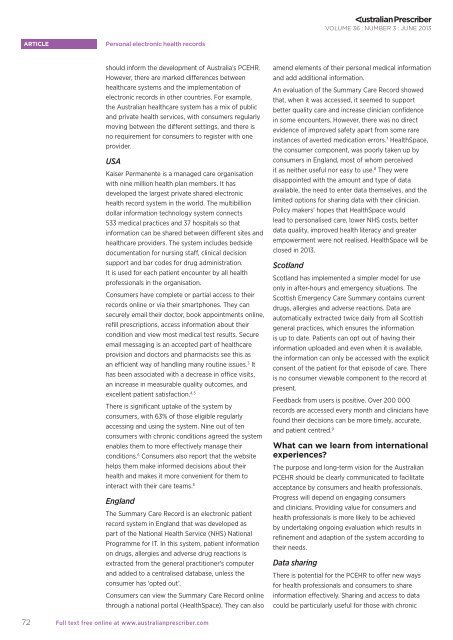download the full PDF issue - Australian Prescriber
download the full PDF issue - Australian Prescriber
download the full PDF issue - Australian Prescriber
Create successful ePaper yourself
Turn your PDF publications into a flip-book with our unique Google optimized e-Paper software.
VOLUME 36 : NUMBER 3 : JUNE 2013<br />
ARTICLE<br />
Personal electronic health records<br />
should inform <strong>the</strong> development of Australia’s PCEHR.<br />
However, <strong>the</strong>re are marked differences between<br />
healthcare systems and <strong>the</strong> implementation of<br />
electronic records in o<strong>the</strong>r countries. For example,<br />
<strong>the</strong> <strong>Australian</strong> healthcare system has a mix of public<br />
and private health services, with consumers regularly<br />
moving between <strong>the</strong> different settings, and <strong>the</strong>re is<br />
no requirement for consumers to register with one<br />
provider.<br />
USA<br />
Kaiser Permanente is a managed care organisation<br />
with nine million health plan members. It has<br />
developed <strong>the</strong> largest private shared electronic<br />
health record system in <strong>the</strong> world. The multibillion<br />
dollar information technology system connects<br />
533 medical practices and 37 hospitals so that<br />
information can be shared between different sites and<br />
healthcare providers. The system includes bedside<br />
documentation for nursing staff, clinical decision<br />
support and bar codes for drug administration.<br />
It is used for each patient encounter by all health<br />
professionals in <strong>the</strong> organisation.<br />
Consumers have complete or partial access to <strong>the</strong>ir<br />
records online or via <strong>the</strong>ir smartphones. They can<br />
securely email <strong>the</strong>ir doctor, book appointments online,<br />
refill prescriptions, access information about <strong>the</strong>ir<br />
condition and view most medical test results. Secure<br />
email messaging is an accepted part of healthcare<br />
provision and doctors and pharmacists see this as<br />
an efficient way of handling many routine <strong>issue</strong>s. 3 It<br />
has been associated with a decrease in office visits,<br />
an increase in measurable quality outcomes, and<br />
excellent patient satisfaction. 4,5<br />
There is significant uptake of <strong>the</strong> system by<br />
consumers, with 63% of those eligible regularly<br />
accessing and using <strong>the</strong> system. Nine out of ten<br />
consumers with chronic conditions agreed <strong>the</strong> system<br />
enables <strong>the</strong>m to more effectively manage <strong>the</strong>ir<br />
conditions. 6 Consumers also report that <strong>the</strong> website<br />
helps <strong>the</strong>m make informed decisions about <strong>the</strong>ir<br />
health and makes it more convenient for <strong>the</strong>m to<br />
interact with <strong>the</strong>ir care teams. 6<br />
England<br />
The Summary Care Record is an electronic patient<br />
record system in England that was developed as<br />
part of <strong>the</strong> National Health Service (NHS) National<br />
Programme for IT. In this system, patient information<br />
on drugs, allergies and adverse drug reactions is<br />
extracted from <strong>the</strong> general practitioner’s computer<br />
and added to a centralised database, unless <strong>the</strong><br />
consumer has ‘opted out’.<br />
Consumers can view <strong>the</strong> Summary Care Record online<br />
through a national portal (HealthSpace). They can also<br />
amend elements of <strong>the</strong>ir personal medical information<br />
and add additional information.<br />
An evaluation of <strong>the</strong> Summary Care Record showed<br />
that, when it was accessed, it seemed to support<br />
better quality care and increase clinician confidence<br />
in some encounters. However, <strong>the</strong>re was no direct<br />
evidence of improved safety apart from some rare<br />
instances of averted medication errors. 7 HealthSpace,<br />
<strong>the</strong> consumer component, was poorly taken up by<br />
consumers in England, most of whom perceived<br />
it as nei<strong>the</strong>r useful nor easy to use. 8 They were<br />
disappointed with <strong>the</strong> amount and type of data<br />
available, <strong>the</strong> need to enter data <strong>the</strong>mselves, and <strong>the</strong><br />
limited options for sharing data with <strong>the</strong>ir clinician.<br />
Policy makers’ hopes that HealthSpace would<br />
lead to personalised care, lower NHS costs, better<br />
data quality, improved health literacy and greater<br />
empowerment were not realised. HealthSpace will be<br />
closed in 2013.<br />
Scotland<br />
Scotland has implemented a simpler model for use<br />
only in after-hours and emergency situations. The<br />
Scottish Emergency Care Summary contains current<br />
drugs, allergies and adverse reactions. Data are<br />
automatically extracted twice daily from all Scottish<br />
general practices, which ensures <strong>the</strong> information<br />
is up to date. Patients can opt out of having <strong>the</strong>ir<br />
information uploaded and even when it is available,<br />
<strong>the</strong> information can only be accessed with <strong>the</strong> explicit<br />
consent of <strong>the</strong> patient for that episode of care. There<br />
is no consumer viewable component to <strong>the</strong> record at<br />
present.<br />
Feedback from users is positive. Over 200 000<br />
records are accessed every month and clinicians have<br />
found <strong>the</strong>ir decisions can be more timely, accurate,<br />
and patient centred. 9<br />
What can we learn from international<br />
experiences<br />
The purpose and long-term vision for <strong>the</strong> <strong>Australian</strong><br />
PCEHR should be clearly communicated to facilitate<br />
acceptance by consumers and health professionals.<br />
Progress will depend on engaging consumers<br />
and clinicians. Providing value for consumers and<br />
health professionals is more likely to be achieved<br />
by undertaking ongoing evaluation which results in<br />
refinement and adaption of <strong>the</strong> system according to<br />
<strong>the</strong>ir needs.<br />
Data sharing<br />
There is potential for <strong>the</strong> PCEHR to offer new ways<br />
for health professionals and consumers to share<br />
information effectively. Sharing and access to data<br />
could be particularly useful for those with chronic<br />
72<br />
Full text free online at www.australianprescriber.com
















